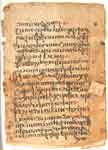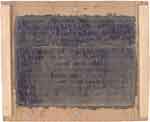
|
Although papyrus was the preferred writing material in ancient Egypt, it was rather expensive. A number of other, cheaper materials were employed which could either be written on with ink or inscribed with a stylus.
Wooden tablets and ostraka (pottery fragments) were readily available materials that could be written on with ink. The ink used was a simple combination of soot, gum arabic, and water; the ink was usually applied with a split reed pen in this time period, but in some cases a reed brush was used.
While most documents are written only in black ink, the standard Egyptian palette consisted of a black and a red ink, usually applied with separate brushes. The Book of the Dead fragment shown below, as well as the later Coptic manuscript, display this dichromatic palette. Also displayed is a scribe's writing kit, which was designed to accomodate both types of ink.
Wooden tablets covered with a thin layer of wax made a convenient writing surface which could be inscribed with a stylus. Tablets made from wood or lead were also occasionally inscribed. Styli could be made from wood, bone, or even metal.
Please continue on to see the final remarks for this
exhibit![]()





